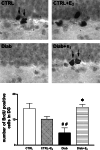Hippocampal neuropathology of diabetes mellitus is relieved by estrogen treatment
- PMID: 16807785
- PMCID: PMC11520735
- DOI: 10.1007/s10571-006-9096-y
Hippocampal neuropathology of diabetes mellitus is relieved by estrogen treatment
Abstract
1. A recently recognized complication of uncontrolled diabetes mellitus is the encephalopathy involving, among other regions, the hippocampus. Since estrogens bring neuroprotection in cases of brain injury and degenerative diseases, we have studied if estradiol (E2) administration counteracts some hippocampal abnormalities of streptozotocin (STZ)-diabetic adult mice. 2. We first report the ability of E2 to modulate neurogenesis in the dentate gyrus (DG) and subventricular zone (SVZ) of diabetic mice. Using bromodeoxyuridine (BrdU) to label newly generated cells, a strong reduction in cell proliferation was obtained in DG and SVZ of mice sacrificed 20 days after STZ administration. The reduction was completely relieved by 10 days of E2 pellet implantation, which increased 30-fold the circulating E2 levels. 3. Diabetic mice also showed abnormal expression of astrocyte markers in hippocampus. Thus, increased number of GFAP(+) cells, indicative of astrogliosis, and increased number of apolipoprotein-E (Apo-E)(+) astrocytes, a marker of ongoing neuronal dysfunction, was found in stratum radiatum below the CA1 hippocampal subfield of diabetic mice. Both parameters were reverted to normal by the E2 regime that upregulated cell proliferation. 4. The studies demonstrated that hippocampal neuropathology of uncontrolled diabetes is a reversible condition and sensitive to estrogen treatment. Studies in animal models may open up new venues for understanding the beneficial role of steroid hormones in diabetic encephalopathy.
Figures




Similar articles
-
Astrocyte-Derived Estrogen Regulates Reactive Astrogliosis and is Neuroprotective following Ischemic Brain Injury.J Neurosci. 2020 Dec 9;40(50):9751-9771. doi: 10.1523/JNEUROSCI.0888-20.2020. Epub 2020 Nov 6. J Neurosci. 2020. PMID: 33158962 Free PMC article.
-
Oestradiol restores cell proliferation in dentate gyrus and subventricular zone of streptozotocin-diabetic mice.J Neuroendocrinol. 2004 Aug;16(8):704-10. doi: 10.1111/j.1365-2826.2004.01223.x. J Neuroendocrinol. 2004. PMID: 15271063
-
Prominently decreased hippocampal neurogenesis in a spontaneous model of type 1 diabetes, the nonobese diabetic mouse.Exp Neurol. 2008 Apr;210(2):359-67. doi: 10.1016/j.expneurol.2007.11.009. Epub 2007 Nov 29. Exp Neurol. 2008. PMID: 18190910
-
Increased astrocyte reactivity in the hippocampus of murine models of type 1 diabetes: the nonobese diabetic (NOD) and streptozotocin-treated mice.Brain Res. 2002 Dec 13;957(2):345-53. doi: 10.1016/s0006-8993(02)03675-2. Brain Res. 2002. PMID: 12445977
-
Steroid protection in aging and age-associated diseases.Exp Gerontol. 2009 Jan-Feb;44(1-2):34-40. doi: 10.1016/j.exger.2008.03.005. Epub 2008 Mar 20. Exp Gerontol. 2009. PMID: 18445514 Review.
Cited by
-
Depressive phenotypes evoked by experimental diabetes are reversed by insulin.Physiol Behav. 2012 Feb 1;105(3):702-8. doi: 10.1016/j.physbeh.2011.09.003. Epub 2011 Sep 10. Physiol Behav. 2012. PMID: 21945451 Free PMC article.
-
Attenuation of vascular dementia by sodium butyrate in streptozotocin diabetic rats.Psychopharmacology (Berl). 2011 Jun;215(4):677-87. doi: 10.1007/s00213-011-2164-0. Epub 2011 Jan 12. Psychopharmacology (Berl). 2011. PMID: 21225418
-
Adult hippocampal neurogenesis: regulation, functional implications, and contribution to disease pathology.Neurosci Biobehav Rev. 2009 Mar;33(3):232-52. doi: 10.1016/j.neubiorev.2008.08.007. Epub 2008 Aug 19. Neurosci Biobehav Rev. 2009. PMID: 18786562 Free PMC article. Review.
-
Heterogeneity of functional activation during memory encoding across hippocampal subfields in temporal lobe epilepsy.Neuroimage. 2011 Oct 15;58(4):1121-30. doi: 10.1016/j.neuroimage.2011.06.085. Epub 2011 Jul 7. Neuroimage. 2011. PMID: 21763431 Free PMC article.
-
Peripheral Levels of AGEs and Astrocyte Alterations in the Hippocampus of STZ-Diabetic Rats.Neurochem Res. 2016 Aug;41(8):2006-16. doi: 10.1007/s11064-016-1912-2. Epub 2016 Apr 15. Neurochem Res. 2016. PMID: 27084774
References
-
- Adeghate, E., and Ponery, A. S. (2001). The effect of 17 beta-estradiol on weight, blood glucose and plasma insulin levels in diabetic rats. Gynecol. Endocrinol.15:433–438. - PubMed
-
- Anderson, M. F., Aberg, M. A. I., Nilsson, M., and Eriksson, P. S. (2002). Insulin-like growth factor-I and neurogenesis in the adult mammalian brain. Dev. Brain Res.4:115–122. - PubMed
-
- Artola, A., Kamal, A., Ramakers, G. M., Gardoni, F., DiLuca, M., Biessels, G. J., Cattabeni, F., and Gispen, W. H. (2002). Synaptic plasticity in the diabetic brain: Advanced aging? Prog. Brain Res. 138:305–314. - PubMed
-
- Behl, C. (2002). Estrogen as a neuroprotective hormone. Nat. Rev. Neurosci. 3:433–442. - PubMed
-
- Bestetti, G., and Rossi, G. L. (1980). Hypothalamic lesions in rats with long-term streptozotocin-induced diabetes mellitus. Acta Neurophatol.52:119–127. - PubMed
Publication types
MeSH terms
Substances
LinkOut - more resources
Full Text Sources
Medical
Miscellaneous

